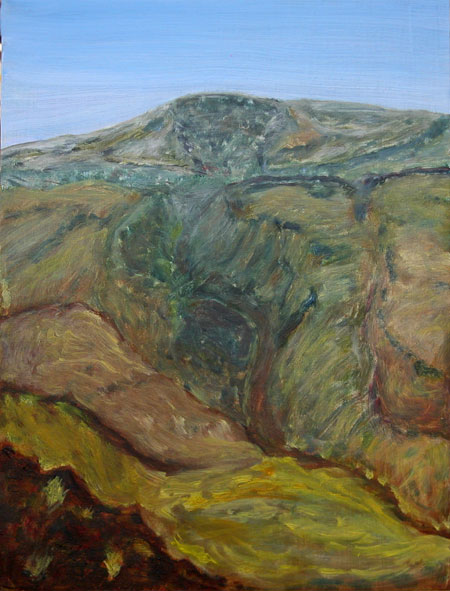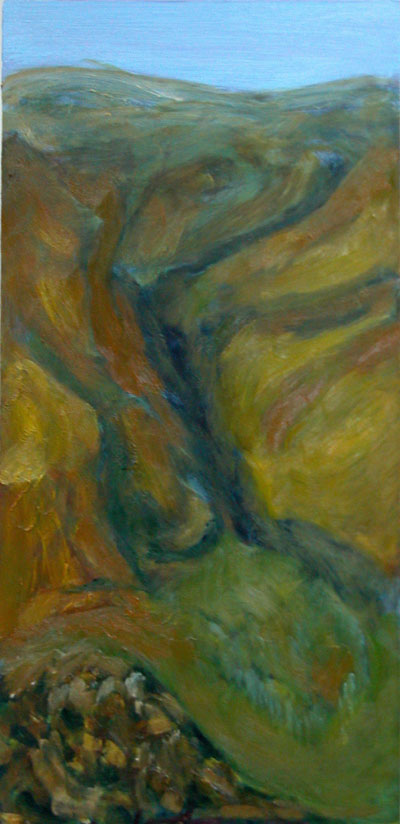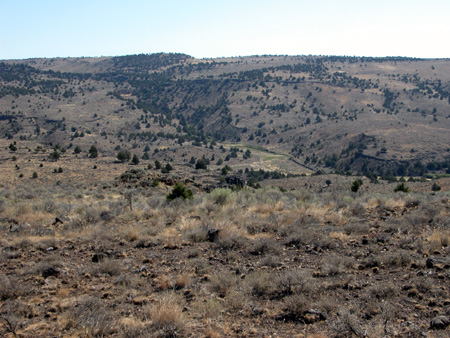Posted by Sunil Gangadharan on September 27th, 2007

Sunil Gangadharan, ‘Battery’, Oil on masonite, 40″ X 44″
I have been exploring new ways of laying a face to the canvas and a technique that I am recently starting to understand is to pattern splotches of color rather than create defined areas of light and dark. It is a time consuming technique even if it looks very random. Previously, the light / dark areas seemed more deliberate and planned with the result that some of my older paintings had ‘islands’ which accentuated the lighting and lack of (no, I am not complaining, only comparing).
In this technique, I did not try and consciously paint ‘islands of light’. Rather, I developed the effects of light from using results of a higher valued hue playing on the transparency of the white ground overlaid with lower valued hues and thicker splotches of paint for completion of darker areas. So here are two new paintings and no contortional contretemps (as June playfully referred to questions/issues raised as a result of my posts).
Comments are most welcome.

Sunil Gangadharan, ‘Belphegor’, Oil on masonite, 40″ X 44″
Posted by Jay on September 21st, 2007
People on this site take their photography seriously.
Me, I play around. I take my camera to a tidy little pond with a walkway in a nearby metro park, where I capture whatever the season and the light permit. Photographing the plant life there is somewhat like shooting fish in a barrel.
There are things that I forswore, but now I swear I do. I once considered the extent of my cunning to constitute the limits of my accomplishment, and looked askance at any number of the tools that I now unabashedly employ. And the images that I bring back from the pond are increasingly subjected to my ever laxer and self-indulgent propensities. Instead of rolling up my sleeves on location and really getting into the moment, I point and shoot and place my faith in the little Photoshop of horrors. This sort of thing was not supposed to happen – my parents raised me better than to click like that.
more… »
Posted by Karl Zipser on September 21st, 2007
The problem with the blog is fixed and we are back in business :-)
Posted by June Underwood on September 14th, 2007



Underwood, Stinking Water Area, large and small oil on masonite, and a photograph, off the Stinking Water Acess Road.
“I took my easel and canvas and brushes to the top of the bluff, and painted two views from the same spot…. From this enchanting spot there was nothing to arrest the eye from ranging over [the Missouri’s] waters for the distance of twenty or thirty miles.”
[Artist George Catlin, as quoted in William H. Truettner, The Natural Man Observed: A Study of Catlin’s Indian Gallery (Washington, D.C.: Smithsonian Institution Press, 1979), p. 247, found on the of the Smithsonian website.
As Karl said (here) one has to become acquainted with the landscape before one can paint it. And as George Catlin remarked about a different landscape “there was nothing to arrest the eye…for the distance of twenty or thirty miles.
Aside from artistic masochism, why do we paint landscapes?
more… »
Posted by June Underwood on August 31st, 2007
I’m just back from a pleine aire, oil painting workshop and it seems that my topic — to paint in the middle in the muddle or to recollect in tranquility — has arisen again on A&P. Hi Sunil…..
Obviously I’m fascinated with the immediate ambiance as much as I am with the final product. The milieu from which I just returned, however, had its problems. The big one was the lack of focus within the landscapes we were asked to paint. So the topic of the day is — how do you find your viewpoints and hold them? more… »
Posted by June Underwood on August 17th, 2007
David Lewis-Williams in The Mind in the Cave and Inside the Neolithic Mind postulates that religion has its origins in hard-wired brain functions he calls “states of altered consciousness.” Among these altered states are the hypnogogic (just prior to and awakening from sleep) as well as states induced by consciously chosen activities, for example, rhythmic dancing, meditation, and persistent highly rhythmical sound patterns. And then there are the other well-known states, whether chosen or inflicted, that alter consciousness — ingestion of psychotropic substances, intense concentration, fatigue, hunger, sensory deprivation, extreme pain, migraine, temporal lobe epilepsy, hyperventilation, electrical stimulation, near-death experiences, and schizophrenia and other pathological conditions (Inside the Neolithic Mind, page 46).
These states of consciousness, combined with homo sapiens’ ability to remember the visions that occur in such states, says Lewis-Williams, account for the rise of religion, some social organizations (primarily religious hierarchies), and the early paintings and art found in western Europe at places like the caves of Lascaux well as in the Near East around the upper reaches of the Tigris-Euphrates, Jordan, and Turkey. more… »
Posted by Sunil Gangadharan on August 9th, 2007
Every time I paint a face, I learn something about the person being painted and something about myself.
A face does not have to be stately or symmetrical, but it needs to speak to me. Oftentimes, I find expressions that I identify with or abhor in these faces. Ultimately, I think it is the expression and implied emotion that carries the painting more than anything else.
Sometimes, the texture of skin may be in synchrony with the emotions depicted while at other times in dissonance. The skin of an old woman’s face that’s wrinkled and leathery with creases might signal decrepitude while at other times the sadness in the eyes and the mouth of a smooth silky skinned prostitute might also signal the same.
This time, I did not want to end this with a question, but wanted to just show this painting that I did a week back. As usual, comments and thoughts most welcome. more… »



